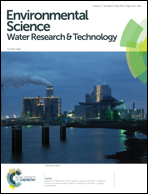Aryl hydrocarbon receptor potency of chlorinated parabens in the aquatic environment†
Abstract
Parabens are widely used as preservatives in personal care products. Parabens and their chlorinated by-products are continuously released into aquatic environments where aryl hydrocarbon receptor (AhR) potency was observed. Chlorinated parabens have structural similarities to hydroxylated polychlorinated biphenyls (PCBs, which also possess AhR potency) in the number of chlorine atoms and hydroxyl groups in the aromatic ring. The aryl hydrocarbon receptor potency of 24 compounds, including chlorinated and non-chlorinated parabens, degradation products of non-parabens, and possible degradation products of chlorinated parabens, was measured using a yeast (YCM3) reporter gene and cytochrome P450 (CYP)1, ethoxyresorufin O-deethylase (EROD) assays. We specifically focused on the AhR potency of parabens in water samples from swimming pools and from rivers receiving effluents from sewage treatment plants (STPs). The yeast assay revealed 16 compounds exhibiting AhR potency, with their potency relative to the AhR ligand β-naphthoflavone (BNF) ranging from 5 × 10−5 to 9 × 10−2. In human hepatoma cell line HepG2, four parabens caused significant induction of EROD activity (p < 0.05); contents of isobutyl paraben (iBP) and dichlorinated isopropyl paraben (Cl2iPP) in each treatment group were 2.6- and 1.8-fold greater, respectively, than that of the vehicle control at 100 μM. The occurrences of all compounds in swimming pool samples and of 20 compounds in river samples were analysed using gas chromatography-mass spectrometry, which revealed total concentrations of 2.7–1100 ng L−1 and 83–4600 ng L−1, respectively. Water samples exhibited AhR potency; their BNF equivalents ranged from 4.0 to 960 pM in pool water and from 25 to 3500 pM in river water. The contribution ratio of active compounds accounted for up to 6.3% (pool water) and 0.94% (river water) of the observed potency of water samples. This study provides the first confirmation of AhR-mediated toxicity of parabens using in vitro assays.


 Please wait while we load your content...
Please wait while we load your content...